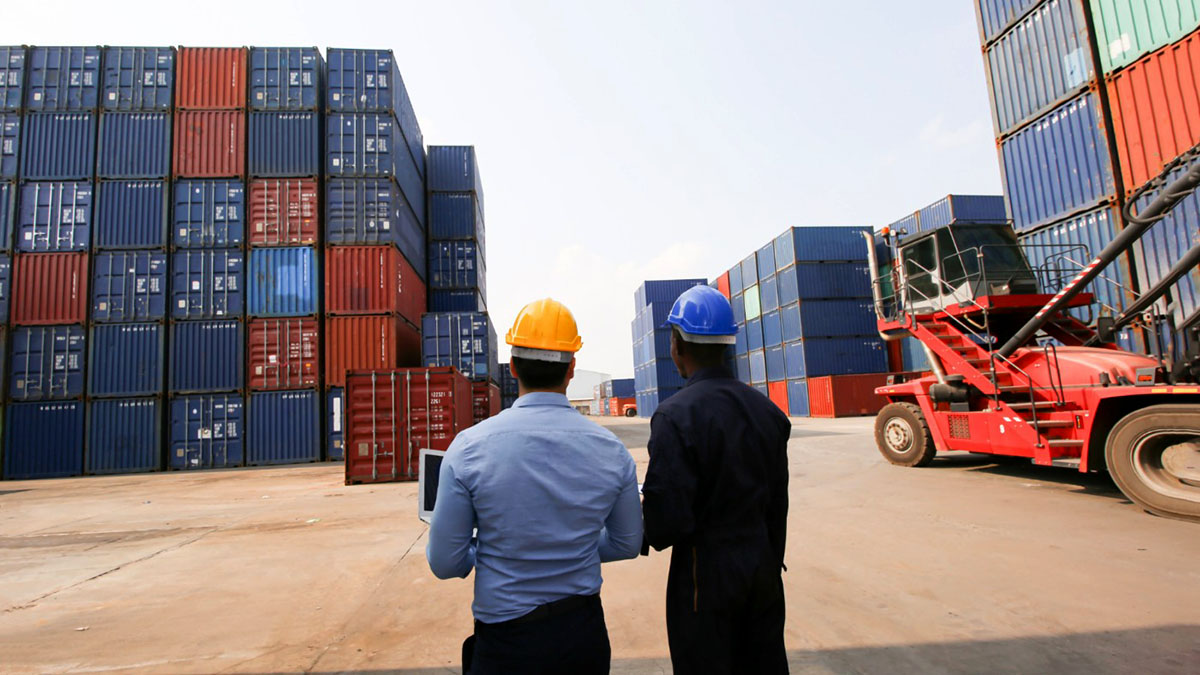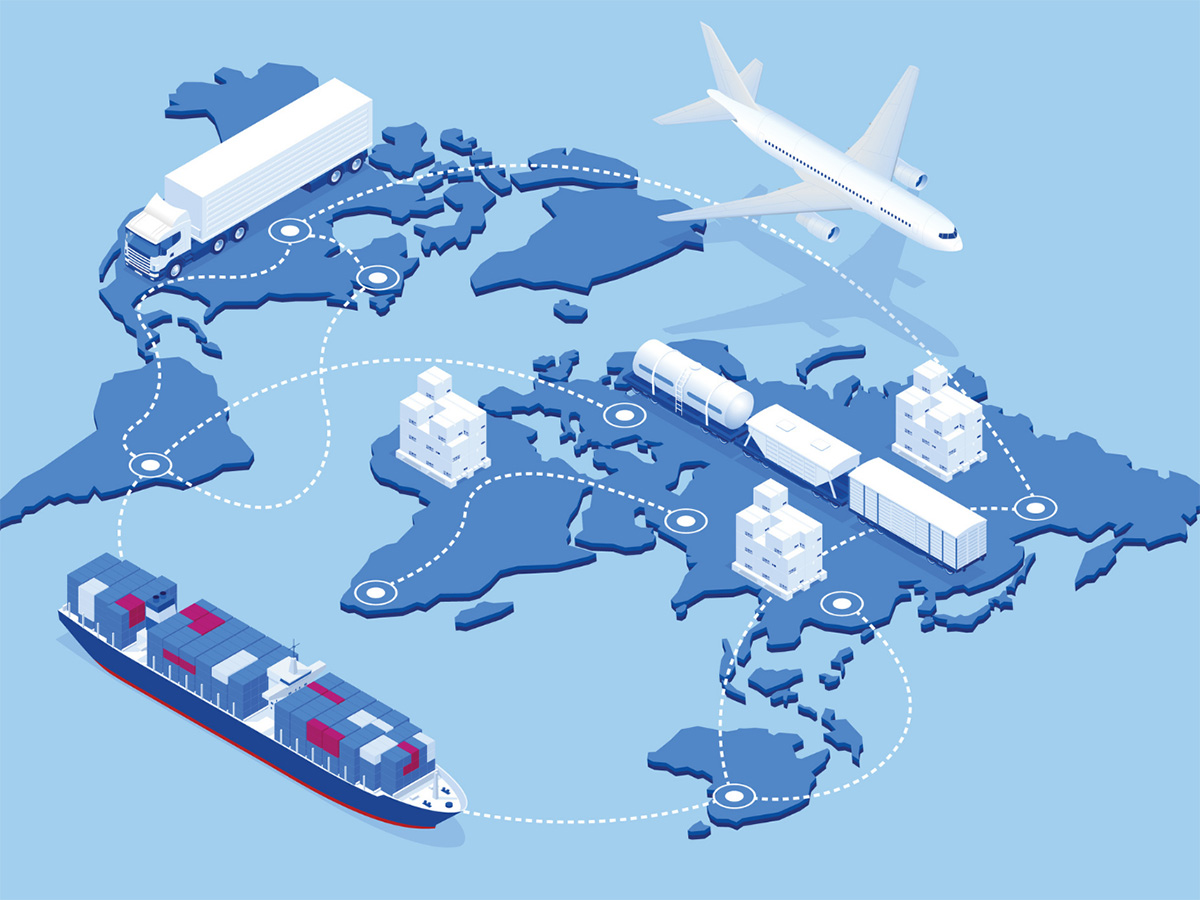

Finance
How To Achieve Supply Chain Visibility
Published: October 19, 2023
Learn how to achieve supply chain visibility and optimize your finance processes with our comprehensive guide. Enhance your financial control and decision-making capabilities.
(Many of the links in this article redirect to a specific reviewed product. Your purchase of these products through affiliate links helps to generate commission for LiveWell, at no extra cost. Learn more)
Table of Contents
- Introduction
- Definition of Supply Chain Visibility
- Benefits of Supply Chain Visibility
- Challenges in Achieving Supply Chain Visibility
- Key Steps to Achieve Supply Chain Visibility
- Implementing Advanced Technologies for Supply Chain Visibility
- Case Studies: Successful Supply Chain Visibility Implementations
- Best Practices for Maintaining Supply Chain Visibility
- Conclusion
Introduction
The world of business and commerce has become increasingly complex, with global supply chains spanning multiple countries and involving numerous stakeholders. In this interconnected landscape, having supply chain visibility is crucial for organizations to effectively manage their operations and make informed decisions. Supply chain visibility refers to the ability to track and monitor the movement of goods, information, and finances across the entire supply chain.
With supply chain visibility, companies can gain real-time insights into the status and location of their products, identify potential bottlenecks or disruptions, and optimize their processes to ensure on-time deliveries and cost efficiencies. It facilitates better collaboration among suppliers, manufacturers, distributors, and retailers, leading to improved customer satisfaction and increased competitive advantage.
Despite the benefits it offers, achieving supply chain visibility is not without its challenges. Legacy systems, manual processes, data silos, and complex networks can hinder the flow of information and make it difficult to gain a holistic view of the supply chain. However, with advancements in technology and the availability of powerful analytics tools, companies can now overcome these obstacles and achieve unparalleled visibility throughout the entire supply chain.
In this article, we will explore the definition of supply chain visibility, delve into its benefits, examine the challenges faced in attaining it, and explore key steps organizations can take to achieve supply chain visibility. We will also discuss the implementation of advanced technologies and share case studies of successful supply chain visibility implementations. Lastly, we will present best practices for maintaining supply chain visibility to ensure long-term success.
Definition of Supply Chain Visibility
Supply chain visibility refers to the ability to track and monitor the movement of goods, information, and finances across the entire supply chain, from the raw materials stage to the end customer. It involves capturing, analyzing, and sharing real-time data and insights about various supply chain activities, including procurement, manufacturing, transportation, warehousing, and inventory management.
At its core, supply chain visibility provides organizations with a comprehensive and transparent view of their supply chain operations. It encompasses the flow of goods, the flow of information, and the flow of finances, enabling companies to gain a clear understanding of the status, location, and condition of their products at any given time.
Supply chain visibility is not simply about tracking the physical movement of goods; it goes beyond that to include the visibility of information flows as well. This means having access to accurate and up-to-date data on order statuses, inventory levels, production schedules, transportation timelines, and any other relevant information that impacts the supply chain. By having this information readily available, businesses can make more informed decisions, identify potential issues or bottlenecks, and respond quickly to changes in demand or disruptions in the supply chain.
Supply chain visibility also extends to the financial aspects of the supply chain. It involves monitoring and analyzing financial transactions, such as purchase orders, invoices, payments, and costs associated with various supply chain activities. By having visibility into the financial flow, organizations can gain insights into the cost drivers, identify areas of inefficiency, and make strategic decisions to optimize their supply chain operations and improve financial performance.
In summary, supply chain visibility encompasses the tracking and monitoring of goods, information, and finances throughout the supply chain. It provides organizations with real-time insights and a holistic view of their supply chain operations, enabling them to make informed decisions, enhance collaboration, improve customer satisfaction, and drive competitive advantage.
Benefits of Supply Chain Visibility
Supply chain visibility offers numerous benefits to organizations across various industries. Let’s explore some of the key advantages:
- Improved Decision-making: With real-time visibility into the supply chain, businesses can make more informed and data-driven decisions. They can analyze the flow of goods, information, and finances, identify bottlenecks, and take proactive measures to optimize their operations. This leads to improved efficiency, reduced costs, and enhanced customer satisfaction.
- Enhanced Collaboration: Supply chain visibility enables better collaboration and communication among different stakeholders in the supply chain, such as suppliers, manufacturers, distributors, and retailers. Having access to real-time data helps in streamlining processes, resolving issues faster, and making joint decisions to meet customer demands more effectively.
- Inventory Optimization: Visibility into inventory levels and demand patterns allows organizations to optimize their inventory management. By having accurate information about stock levels, they can prevent stockouts, minimize excess inventory, and improve forecasting accuracy. This reduces holding costs and improves working capital management.
- Enhanced Customer Service: Supply chain visibility enables organizations to provide better customer service. By knowing the exact location and status of goods, they can provide accurate delivery estimates and updates to customers. This builds trust, increases customer satisfaction, and improves loyalty.
- Risk Mitigation: Visibility into the supply chain helps in identifying and mitigating potential risks. Whether it’s a disruption in the transportation network, quality issues with suppliers, or geopolitical factors impacting sourcing, organizations can quickly identify risks and implement contingency plans to minimize the impact on their operations.
- Optimized Supply Chain Network: With supply chain visibility, organizations can analyze the performance of their suppliers, transportation partners, and other stakeholders. They can identify bottlenecks, underperforming areas, and opportunities for improvement. This allows them to optimize their supply chain network, streamline processes, and ensure efficient and cost-effective operations.
In summary, supply chain visibility brings significant benefits to organizations, including improved decision-making, enhanced collaboration, inventory optimization, better customer service, risk mitigation, and optimized supply chain network. By leveraging visibility, organizations can gain a competitive edge and drive operational excellence in today’s dynamic business landscape.
Challenges in Achieving Supply Chain Visibility
While the benefits of achieving supply chain visibility are undeniable, there are several challenges that organizations must overcome to attain it. Let’s explore some of the key obstacles:
- Data Silos: In many organizations, data related to the supply chain is often scattered across various systems and departments, leading to data silos. This fragmentation makes it difficult to gain a holistic view of the supply chain and inhibits the sharing of real-time information.
- Legacy Systems: Many organizations still rely on outdated legacy systems that lack the capability to capture and integrate real-time data. These systems are often inflexible, making it challenging to collect and analyze data from different sources and provide timely insights.
- Complex Networks: Global supply chains involve multiple stakeholders, including suppliers, manufacturers, distributors, and retailers, spread across different geographies. Managing the complexities of these networks and ensuring visibility across all stages can be a significant challenge.
- Limited Supply Chain Collaboration: Lack of collaboration and information sharing among different stakeholders is a common challenge. Limited visibility can lead to delays, miscommunication, and inefficiencies, thereby hindering the flow of goods, information, and finances in the supply chain.
- Lack of Standardization: The absence of standardization in processes, data formats, and communication protocols across the supply chain can create barriers to achieving visibility. Different systems and stakeholders may use different formats and procedures, making it difficult to integrate and share information seamlessly.
- Security and Privacy Concerns: Sharing sensitive supply chain data with external stakeholders can raise security and privacy concerns. Organizations must establish robust cybersecurity measures and implement secure data-sharing protocols to safeguard sensitive information.
Overcoming these challenges requires a strategic approach and the adoption of advanced technologies and best practices. Organizations need to break down data silos, upgrade their legacy systems, foster collaboration among stakeholders, establish data standardization protocols, and prioritize data security and privacy.
In the next section, we will discuss the key steps that organizations can take to achieve supply chain visibility and address these challenges effectively.
Key Steps to Achieve Supply Chain Visibility
While achieving supply chain visibility can be a complex task, organizations can follow several key steps to ensure success. Let’s explore these steps:
- 1. Assess Current Visibility: Start by assessing the existing level of visibility in your supply chain. Identify gaps, determine the scope of data needed, and evaluate the current processes and technologies in place. This assessment will serve as a baseline to identify areas for improvement.
- 2. Break Down Data Silos: Address the challenge of data silos by implementing integration technologies that connect different systems and enable real-time data sharing. Use application programming interfaces (APIs), data warehouses, or cloud-based platforms to integrate data from various sources, ensuring a unified and centralized view of the supply chain.
- 3. Standardize Data and Processes: Establish data and process standardization protocols across the supply chain network. Use common data formats, communication protocols, and terminology to ensure seamless information exchange and interoperability between different stakeholders and systems. This standardization enables accurate and consistent visibility throughout the supply chain.
- 4. Implement Advanced Analytics: Leverage advanced analytics technologies such as machine learning and predictive analytics to gain actionable insights from the vast amounts of supply chain data. By analyzing historical and real-time data, you can identify trends, patterns, and anomalies, enabling proactive decision-making and risk mitigation.
- 5. Embrace Internet of Things (IoT) and Sensor Technologies: Deploy IoT devices and sensors throughout the supply chain to capture real-time data on the location, condition, and movement of goods. This IoT-enabled visibility allows for accurate tracking and monitoring of assets, ensuring timely deliveries and proactive issue resolution.
- 6. Collaborate with Suppliers and Partners: Establish strong collaboration and information-sharing mechanisms with suppliers, manufacturers, distributors, and logistics partners. Implement shared platforms, portals, or systems that allow for the seamless exchange of data, enabling end-to-end visibility across the entire supply chain network.
- 7. Use Supply Chain Visibility Tools: Adopt supply chain visibility software and tools that provide real-time dashboards, alerts, and analytics. These tools help visualize supply chain data, monitor key performance indicators (KPIs), and provide insights to make informed decisions.
- 8. Continuously Monitor and Improve: Achieving and maintaining supply chain visibility is an ongoing process. Continuously monitor the performance of your supply chain, identify areas for improvement, and implement corrective actions. Regularly evaluate the effectiveness of your visibility initiatives and adjust your strategies accordingly.
By following these key steps, organizations can overcome the challenges and achieve supply chain visibility. Remember that each step is interconnected, and a holistic approach is essential. Strive for collaboration, standardization, and the adoption of advanced technologies to unlock the full potential of your supply chain.
Implementing Advanced Technologies for Supply Chain Visibility
Implementing advanced technologies is essential for achieving comprehensive supply chain visibility. These technologies enable organizations to capture, analyze, and share real-time data across the entire supply chain network. Let’s explore some of the key technologies that can be leveraged:
- Internet of Things (IoT): IoT devices and sensors are powerful tools for capturing and transmitting real-time data on the status, location, and condition of goods. By embedding sensors in packages, containers, or vehicles, organizations can track and monitor the movement of goods, temperature, humidity, and other relevant parameters. This data provides valuable insights for optimizing logistics, ensuring product quality, and facilitating timely deliveries.
- Blockchain: Blockchain technology offers secure and transparent transactional records, enabling trust and traceability in the supply chain. It ensures the immutability and authenticity of data, reducing the risk of fraud and improving supply chain visibility. By implementing blockchain, organizations can track product origins, verify the authenticity of goods, and enhance transparency among multiple parties.
- Advanced Analytics: Utilizing advanced analytics, including artificial intelligence (AI) and machine learning (ML), allows organizations to analyze vast amounts of supply chain data. These technologies provide actionable insights, identify patterns and trends, and enable predictive analytics. By leveraging AI and ML algorithms, organizations can optimize inventory management, improve demand forecasting, and detect potential supply chain disruptions.
- Cloud Computing: Cloud-based platforms provide scalable and flexible solutions for supply chain visibility. Cloud computing enables real-time data sharing and collaboration among different stakeholders in the supply chain network. It allows for centralized data storage, accessibility from any location, and integration with other systems. Organizations can leverage cloud-based solutions to streamline communication, enhance traceability, and enable seamless information exchange.
- Big Data Analytics: With the exponential growth of data in supply chains, organizations can unlock insights from big data analytics. By analyzing large datasets from various sources, including sales data, customer feedback, social media, and sensor data, organizations can uncover hidden patterns, make data-driven decisions, and identify potential supply chain optimization opportunities.
- Artificial Intelligence and Machine Learning: AI and ML empower organizations to automate and optimize supply chain processes. AI-powered algorithms can analyze historical data, identify patterns, and make accurate predictions. Machine learning models can optimize demand forecasting, routing decisions, and inventory management, leading to improved supply chain visibility and operational efficiency.
- Data Integration and Visualization Tools: Implementing data integration and visualization tools is crucial for aggregating and presenting supply chain data in a user-friendly and actionable way. These tools enable real-time dashboards, interactive reports, and data visualizations that provide key metrics and KPIs. This allows stakeholders to quickly identify bottlenecks, track performance, and make informed decisions.
By strategically implementing these advanced technologies, organizations can unlock the full potential of supply chain visibility. However, it is important to carefully evaluate and select the technologies that align with specific business needs, scalability requirements, and budget constraints.
Case Studies: Successful Supply Chain Visibility Implementations
To illustrate the benefits and feasibility of achieving supply chain visibility, let’s explore a couple of real-world case studies:
Case Study 1: Walmart
Walmart, one of the world’s largest retailers, embarked on a journey to improve its supply chain visibility. The company implemented advanced technologies such as RFID (Radio Frequency Identification) tags and satellite tracking systems to monitor the movement of goods from suppliers to stores. By leveraging these technologies, Walmart achieved real-time visibility into inventory levels, delivery timelines, and product availability.
The implementation of supply chain visibility enabled Walmart to streamline its inventory management processes and reduce out-of-stock situations. With accurate and up-to-date data, the company optimized its inventory levels, improved product availability, and enhanced customer satisfaction. Additionally, the visibility into the supply chain allowed Walmart to identify operational inefficiencies, reduce transportation costs, and minimize waste.
Case Study 2: Maersk Line
Maersk Line, a global shipping company, recognized the need to improve supply chain visibility for its customers. By leveraging advanced technologies and data sharing platforms, Maersk implemented a comprehensive supply chain visibility solution called Maersk Line Remote Container Management (RCM).
The RCM system allows customers to track and monitor the location, condition, and status of their containers in real-time. It utilizes IoT sensors and devices installed in the containers to provide accurate data on parameters such as temperature, humidity, and shock. This level of visibility enables customers to proactively manage their supply chain operations, mitigate risks, and ensure product quality.
Maersk Line’s supply chain visibility implementation has not only improved customer satisfaction but also enhanced operational efficiency. The company gained insights into container utilization, route optimization, and maintenance needs, leading to cost savings and improved asset management.
These case studies emphasize the benefits and possibilities of achieving supply chain visibility through advanced technologies. By leveraging real-time data, organizations can optimize their supply chain operations, improve customer satisfaction, and drive competitive advantage.
Best Practices for Maintaining Supply Chain Visibility
Maintaining supply chain visibility is an ongoing effort that requires continuous monitoring, adaptation, and improvement. Here are some best practices to ensure the long-term success of your supply chain visibility initiatives:
- Establish Clear Communication Channels: Foster open and transparent communication channels with all stakeholders in the supply chain. Ensure that information flows smoothly among suppliers, manufacturers, distributors, and retailers. Implement regular meetings, share relevant data, and promote collaboration to maintain visibility and resolve issues promptly.
- Use Key Performance Indicators (KPIs): Define and monitor key performance indicators specific to supply chain visibility. Track metrics such as on-time delivery, inventory accuracy, order cycle time, and customer satisfaction. Continuously assess and optimize these KPIs to align with evolving business objectives and market demands.
- Invest in Data Quality: Data accuracy and reliability are paramount for maintaining supply chain visibility. Implement data governance practices to ensure data integrity, consistency, and standardization. Regularly validate and update data to prevent inaccuracies and invalid information from affecting visibility and decision-making.
- Implement Security Measures: Strengthen data security and privacy protocols to protect sensitive supply chain information. Implement robust cybersecurity measures, authentication processes, and access controls to safeguard data from unauthorized access or breaches. Regularly audit and update security measures to stay ahead of evolving threats.
- Continuously Evaluate Technology Solutions: Regularly assess and update the technologies and systems supporting supply chain visibility. Stay informed about emerging technologies and trends. Evaluate if your current tools are meeting your needs and consider adopting new solutions or upgrading existing ones to keep up with industry advancements.
- Regularly Train and Educate: Conduct regular training programs to ensure that employees understand the importance of supply chain visibility and know how to utilize the systems and technologies in place. Encourage ongoing education in industry best practices, emerging technologies, and supply chain trends to foster a culture of continuous improvement and knowledge sharing.
- Monitor and Analyze Supply Chain Data: Regularly analyze supply chain data to identify trends, patterns, and areas for improvement. Leverage analytics tools and technologies to gain insights, detect anomalies, and optimize supply chain processes. Continuously monitor performance metrics and benchmark against industry standards to drive efficiency and identify opportunities for enhancement.
- Cultivate Supplier and Partner Relationships: Strengthen relationships with suppliers and partners to enhance visibility and collaboration. Encourage them to adopt supply chain visibility practices, share relevant data, and align with your visibility goals. Establish trust, promote clear communication, and work towards mutual benefits to create a seamless and transparent supply chain network.
By following these best practices, organizations can maintain the visibility necessary for efficient supply chain management. Regular evaluation, adaptation to new technologies, and the implementation of effective communication and security measures will ensure ongoing success in supply chain visibility initiatives.
Conclusion
Supply chain visibility is a crucial aspect of modern business operations, enabling organizations to effectively manage their supply chains and make informed decisions. By implementing supply chain visibility initiatives, companies can gain real-time insights into the movement of goods, information, and finances throughout the supply chain.
In this article, we explored the definition of supply chain visibility and its benefits. We discussed the challenges organizations face in achieving visibility and outlined key steps to attain it, including breaking down data silos, standardizing processes, and leveraging advanced technologies such as IoT, blockchain, and advanced analytics.
We also highlighted successful case studies, such as Walmart and Maersk Line, which demonstrated the tangible benefits of achieving supply chain visibility. These organizations were able to streamline operations, reduce costs, improve customer satisfaction, and gain a competitive edge.
To maintain supply chain visibility, it is important to follow best practices, including clear communication channels, the use of key performance indicators, investing in data quality, implementing security measures, evaluating technology solutions, continuous training, and cultivating relationships with suppliers and partners. These practices ensure sustainable visibility and enable organizations to adapt to changing business requirements.
As businesses navigate increasingly complex supply chains, the importance of supply chain visibility cannot be overstated. It not only improves operational efficiency and reduces costs but also enhances customer service and helps organizations stay competitive in the global marketplace. By prioritizing supply chain visibility, organizations can optimize their supply chain processes, minimize risks, and achieve long-term success.














